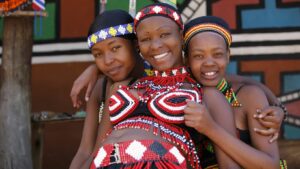African dresses, a vibrant blend of tradition and modernity, are making waves in the global fashion scene. They’re not just pieces of fabric, but a rich tapestry of culture, history, and identity woven into captivating designs.
From the intricate patterns of Ankara to the flamboyant hues of Kente, African dresses serve as a mirror reflecting the continent’s diverse cultures. They’re a testament to Africa’s creative spirit, and their popularity only continues to soar.
In this article, we’ll explore the fascinating world of African dresses, delving into their origins, significance, and evolution. We’ll also highlight how these dresses are influencing and reshaping contemporary fashion.
Africa Dresses

Delving into the realm of the history of African dresses, one encounters a rich tapestry woven over time, influenced significantly by Africa’s diverse cultures, local resources, and the impact of colonization.
The Origins of Traditional Wear
African dresses trace their roots deep into history. Prior to the advent of written languages, African societies used clothing as a form of non-verbal communication, embedding dramatic motifs, symbols, and vibrant colors into their attire. For instance, the Ghanaian Kente cloth signified social status while the South African Xhosa garments reflected key life events.
Each region developed distinct styles, materials, and methods over time, relating to the environment, local resources, and societal norms. The Ashanti region used intricately woven cotton fabrics, while the Maasai women traditionally embroidered vivid beadwork onto leather dresses.
In essence, the traditional wear mirrored intricate societal systems, reflecting age, marital status, wealth, and social standing through complex color symbolism, patterns, and design.
Influence of Colonialism on African Attire
The advent of colonialism marked a significant shift in the style and symbolism of African dresses. Clothing, once recognized for its roots in rich cultural traditions and societal roles, adapted to the European sartorial norms imposed by colonial rule. The colonial influence was noticeable in the adoption of tailored clothing styles, especially by the educated and the urban residents.

Despite this, several traditional elements were retained. Brightly colored fabrics, Indigo dye techniques, and patterns found a place in the colonial-infused clothing, creating a milieu of traditional African and European styles. Additionally, textiles like the Dutch wax print, although initially of foreign origin, assimilated into the African culture, becoming a symbol of pan-African identity.
Colonialism, thus, dichotomized African attire, leading African dresses to tread the path between tradition and modernity, weaving a history steeped in resilience, adaptation, and the enduring strength of cultural identity.
Key Features of African Dresses
African dresses, with their distinct styles and stunning designs, hold intrinsic features that accentuate the cultural depth and heritage of the African continent. This section outlines two significant features of African dresses: vibrant color patterns with potent symbolism, and the use of signature fabrics and materials.
Colorful Patterns and Symbolism
African dresses often feature bright, eye-catching patterns which serve greater meaning than mere aesthetic appeal. Each design, be it geometric shapes or intricate motifs, represents an elemental symbolism deeply rooted in African culture. For example, in many West African societies, zigzag patterns symbolize life’s unpredictable path, while Kente cloth patterns reflect concepts such as human behavior, ethics, or societal values.
Signature Fabrics and Materials

African dresses couple their vibrant patterns with the use of unique, signature fabrics. One prime example is the aforementioned Kente cloth from Ghana, which is handwoven on a traditional loom. Other notable fabrics include Ankara cotton, which is famous for its durability and vividly dyed patterns, and Mud cloth from Mali, characterized by its earthy tones and symbolic motifs. These materials grant African dresses a distinct texture and aesthetic charm, rendering them immediately recognizable and culturally significant.
Conclusion
African dresses, with their vibrant colors and signature fabrics, have made a significant mark on the global fashion scene. Their unique blend of tradition and modernity is a testament to the resilience and adaptability of African societies. From the Ghanaian Kente cloth to South African Xhosa garments, the cultural significance of these attires is deeply rooted in history.
